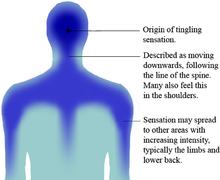ASMR

Autonomous sensory meridian response (ASMR, sometimes auto sensory meridian response)[2][3][4] is a tingling sensation. It often starts on the scalp, and moves down the back of the neck and upper spine. It is an unusual feeling which has no obvious physical cause. (paresthesia)[5] It has been compared with auditory-tactile synesthesia.[6][7]
People who experience ASMR have a "low-grade euphoria". which means they like it. It has "a combination of positive feelings and a distinct static-like tingling sensation on the skin". ASMR is often set off by some auditory or visual stimuli.[1][8] There are videos which try to stimulate ASMR: over 13 million are on YouTube.[9]
References[change | change source]
- ↑ 1.0 1.1 Barratt, Emma L. & Davis, Nick J. (2015). "Autonomous Sensory Meridian Response (ASMR): a flow-like mental state". PeerJ. 3: e851. doi:10.7717/peerj.851. ISSN 2167-8359. PMC 4380153. PMID 25834771.
- ↑ Rhodri Marsden, ''Maria spends 20 minutes folding towels': Why millions are mesmerised by ASMR videos' (21/07/12) on The Independent
- ↑ Kelsey McKinney, 'These Mesmerizing, Satisfying Slime Videos Are the Internet’s New Obsession' (13/04/17) on Intelligencer
- ↑ Amol Rajan, 'ASMR is now mainstream' (23/04/19) on the BBC
- ↑ Tihanyi, Benedek T.; Ferentzi, Eszter; Beissner, Florian; Köteles, Ferenc (1 February 2018). "The neuropsychophysiology of tingling". Consciousness and Cognition. 58: 97–110. doi:10.1016/j.concog.2017.10.015. ISSN 1053-8100. PMID 29096941. S2CID 46885551.
- ↑ Simner, Julia; et al. (2006). "Synaesthesia: the prevalence of atypical cross-modal experiences" (PDF). Perception. 35 (8): 1024–1033. doi:10.1068/p5469. PMID 17076063. S2CID 2508540.
- ↑ Banissy, Michael J.; et al. (15 December 2014). "Synesthesia: an introduction". Frontiers in Psychology. 5 (1414): 1414. doi:10.3389/fpsyg.2014.01414. PMC 4265978. PMID 25566110.
- ↑ Ahuja, Nitin K. (2013). "'It feels good to be measured': clinical role-play, Walker Percy, and the tingles". Perspectives in Biology and Medicine. 56 (3): 442–451. doi:10.1353/pbm.2013.0022. PMID 24375123. S2CID 43492129.
- ↑ "Brain tingles: First study of its kind reveals physiological benefits of ASMR". ScienceDaily. Retrieved 2019-10-23.
